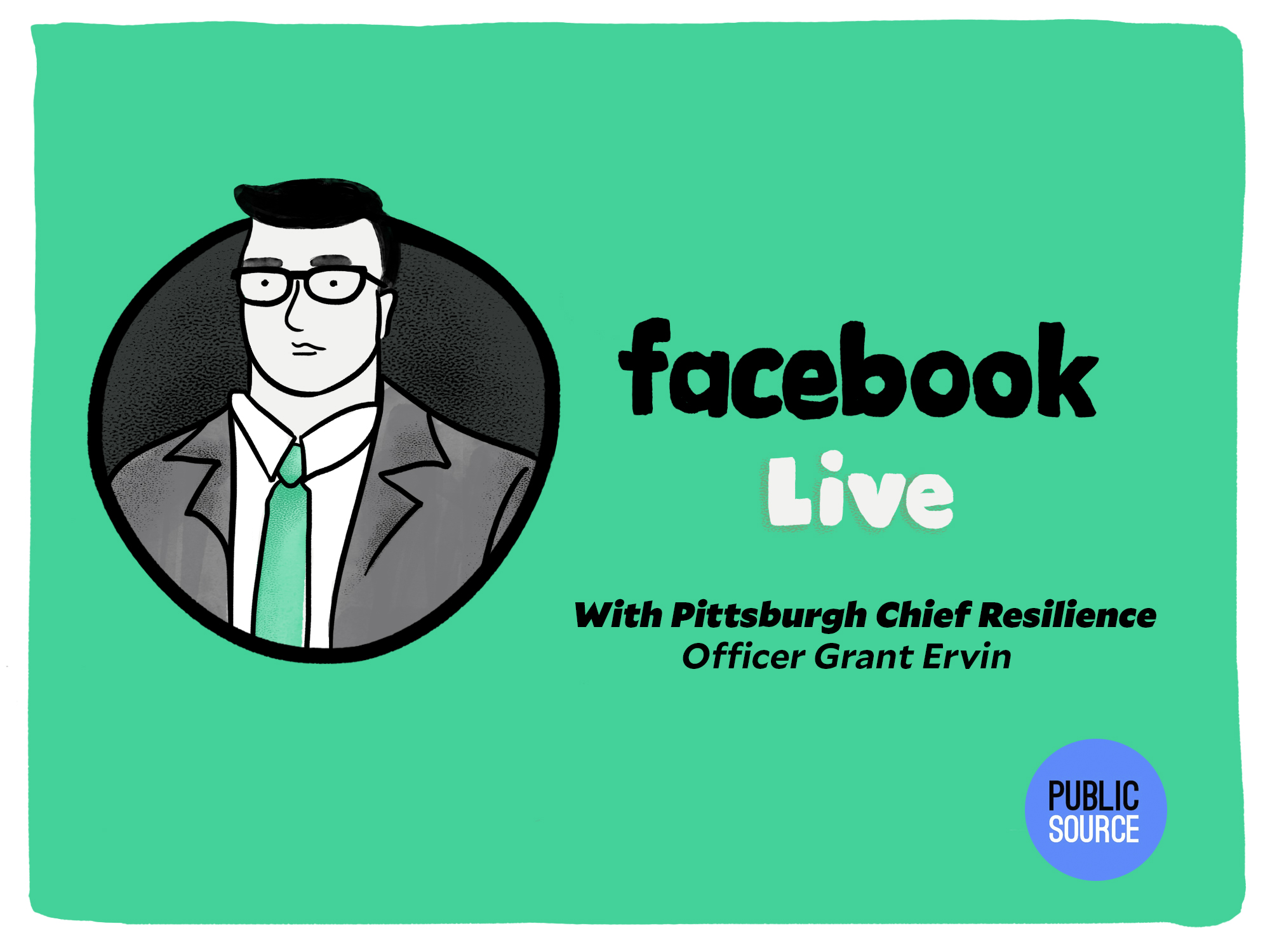
(Photo illustration by Idil Gozde.)

(Photo illustration by Idil Gozde.)
Grant Ervin, Pittsburgh’s chief resilience officer, sat down with PublicSource for a Facebook Live interview about the city’s plans to tackle climate change.
You can watch the whole interview in the video above. But here were three of the best moments:
At about 37 minutes into the video: The most common question was about why Pittsburgh Mayor Bill Peduto and Ervin haven’t been speaking out against the new ethane cracker plant in Beaver County and the growth of the petrochemical industry in Southwestern Pennsylvania. (Ervin refers to it as ethylene; ethane is feedstock for ethylene production.)
Ervin admitted it’s a problem. He said the emissions from the new cracker plant, about 2 million tons of greenhouse gases per year, would offset all the progress the city plans to make at reducing its own emissions by 2030.
“So those are numbers we can’t argue with,” he said. “That’s math.”
So he said he’s been trying to make the case to local city and county leaders that they have to start thinking about investing in a greener future, similarly to the approach the City of Buffalo has taken. The city has attracted investment for a solar cell manufacturing plant from Panasonic that will then be sold to Tesla and turned into solar roofs.
“We are one municipality of 2,600 in the state of Pennsylvania. One of 130 in Allegheny County,” he said. “What we can do is lay out that case.”
PublicSource viewers said they wanted Ervin and the mayor to speak out more critically against the plant as well.
He said residents can expect to see him speaking out more frequently in 2018 about the realities of the region’s energy industry.
“We know this has impact on our population and we want those to be mitigated because it has health impacts, because it has economic impacts,” he said.
He advocated for finding a middle ground between environmental and economic interests because natural gas remains such a critical part of the local economy. “If you remove natural gas…a lot of people wouldn’t be able to heat their homes,” he said.
At about 1 minute and 45 seconds into the interview: The first question of the interview was a tongue-in-cheek reference to several recent comments from high-profile lawmakers, including President Donald Trump, who have called global warming and climate change into question by pointing out the cold weather.
In the East, it could be the COLDEST New Year’s Eve on record. Perhaps we could use a little bit of that good old Global Warming that our Country, but not other countries, was going to pay TRILLIONS OF DOLLARS to protect against. Bundle up!
— Donald J. Trump (@realDonaldTrump) 29 December 2017
Ervin said Pittsburgh’s recent cold snap may actually be another indicator of climate change.
“Across the system we see changes happening,” he said. “Take the bomb cyclone of last week. It’s a little bit out of the norm. They are indicators we’ve seen as part of the larger changing climate. Locally we’ve seen complaints of increased flooding, water in basements, flooding in backyards, things that are typical in Pittsburgh, but the frequency and intensity has increased.”
At about 15:30 minutes into the interview: Ervin told a story about how he had to make a decision that would impact his carbon footprint for years to come, right after his first daughter was born.
The story was an example to Ervin about how challenging it can be to take on climate change, but also how we all need to think about these major life decisions ahead of time.
“It started with the birth of my first daughter. So she was born at the end of January. It was cold much like it is today. Looking back on it, there is some humor in it. ...My wife instructed me to head home and check on the cat. And I went to go check in on our cat and went, ‘Man, it’s really kind of chilly in here.’ And I noticed that our furnace had gone out.”
He figured the furnace in their 1920 home was 30 to 35 years old.
“And here I was confronted with a decision that I’m going to have to make a major household appliance selection and I’m going to have to do it really fast because my wife and daughter were coming back from the hospital the next day.
“And what you found is that it is not an easy consumption decision. You just don’t pick up the phone and order a new furnace. It’s a major capital investment for a homeowner. It requires a lot of upfront planning, both in terms of financing, finding a plumber, somebody who can install it and finding the right piece of equipment. And it has a dollar cost to the decision.”
Ervin said he purchased a furnace that was much more efficient than the old one, but not the top of the line, which would have cost up to a $1,000 more.
“So these are the Ys in the road that as individual consumers that we are confronted with. So the lesson
there for me is to think upfront on some of those things you need to inspect regularly, make some conscious energy planning as part of your normal household budgeting.”
Story by Oliver Morrison
Edited by Halle Stockton and Mila Sanina
Illustrations by Idil Gözde
Design and development by Natasha Khan
Have additional questions or thoughts about this story? Email Oliver at oliver@publicsource.org or find him on Twitter @ORMorrison.